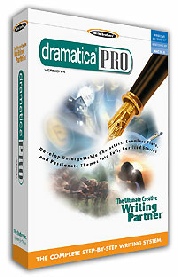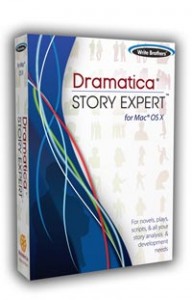This is a transcription of an online audio recording I made in 1996:
Hi, this is Melanie Anne Phillips with another Dramatica Sound Byte. Today's topic: The Story Mind. Story mind... what is that? And more importantly, what does it have to do with writers or writing? Well, if there is a central concept to the Dramatica Theory of Story, it is the notion of The Story Mind. According to Dramatica theory, every complete story is an analogy to a single human mind, trying to deal with an inequity. That's quite a mouthful, so let me say it once again for clarity. Dramatica sees every complete story as an analogy to a single human mind trying to deal with an inequity.
In other words, stories are not really about characters, plot, theme, and genre, but rather, characters, plot, theme, and genre represent different families of consideration that go on in a single human mind when it is trying to come to terms with an inequity. Characters are the different motivations of the Story Mind that influence each other, jockey for position, or come into conflict. Theme represents the value standards of the Story Mind - the measuring sticks by which the Story Mind determines what is better and what is worse. Plot demonstrates the Story Mind's methodologies or techniques it employs in trying to resolve the inequity at the heart of the story. And genre determines the Story Mind's personality - what kind of a mind it is that is doing this consideration.
Well, that's a rather bold statement to make. After all, why would such a complex model of psychology end up being at the center of story structure? Surely writers didn't sit down and say, "I think I'll write an analogy to a single human mind trying to deal with an inequity." Not hardly. So where does the Story Mind come from? According to Dramatica, this model of the mind happens quite naturally, by itself, as a byproduct of the process of communication.
When we seek to communicate we can't reach our audience directly - mind to mind . Rather, we must transmit our message through a medium. To do this, we fashion a symbolic representation of what we have in mind in the hope it will affect our audience the same way it does us. In effect, we create a model of what we are thinking and feeling for the audience to embrace. Which symbols we use depends upon our personal experiences and the culture in which we are working. But beneath the specific symbols are the essential human qualities that are the same in all of us - all cultures and all times.
In and of themselves, these qualities do not yet constitute a model of the mind. For example, if we wanted to convey fear, then we would choose a symbol that would invoke fear in our audience. That human quality would then be communicated. But it is only a small part of what makes up each of our minds.
As communication evolved, the earliest storytellers progressed beyond simply expressing basic emotions or single concepts and began to tell tales. A tale is a progession of symbols that connect one feeling or consideration to the next in an unbroken chain. In this way, an author could lead an audience along an emotional journey and also illustrate that a particular approach led to a particular outcome.
It didn't take these authors long to realize, however, that the human heart cannot leap from one emotion to another indescriminately without passing through the emotions in between. This concept is well documented in The Seven Stages of Grief, and even in Freud's Stages of human development.
Similarly, a logistic chain must not skip any links or it will be held as invalid. So, when telling a tale, the early storytellers developed a feel for which intermediate symbolic steps were required to get from one point of view to another, both logistically and emotionally. We see the result of these discoveries in concepts such as the hero's journey, and story as myth.
Still, this is not a complete model of the mind. A tale is simply a statement that a series of concepts led from point A to point B. In other words, the message of a tale is that a particular series of events can happen. It will be accepted or rejected by an audience solely on the basis of taking the right steps logistically and making the right connections emotionally. Yes, this could happen, or no it could not.
Many fine works through the ages and even today in novels, motion pictures and television are really not complete stories, but simply tales. So what constitutes a story? Well, if a tale is a statement, then a story is an argument. A tale says, "this path led to this outcome indicating it is a good way or a bad way to go about solving a problem". A tale states that a particular outcome is possible. A story says, "this path always leads to this outcome indicating it is always a good way or a bad way to go about solving a problem". A story argues that a particular outcome is inevitable.
If an early author made a statement that a particular case was good or bad, he or she would simply have to prove that a particular approach led to a positive or negative outcome. But if that author tried to tell the audience the approach was always good or always bad, more than likely someone in the audience would "Well, what about under these conditions," or "what about in this context?" Being right there, the author could counter that rebuttal by explaining how the approach would still be best or worst even in that additional case. He or she would either make the point, or fail to make it, in which case the argument would be lost, and the tale would remain as a only a statement, true for that case alone.
As the art of communication evolved beyond the spoken word to the written word, however, the author was no longer physically present to argue the point. Instead, if an author wanted to "prove" inevitability, he or she would have to anticipate all resonable challenges to that statement, and preclude dissension by incorporating all appropriate arguments in the work itself. In this manner, by the time the story is told, not only is a statement made that an approach is good or bad, but all necessary supporting arguments have also been made to "prove" it could not be any other way.
To make these supporting arguments, an author needs to look at the story not only from his or her own point of view, but to anticipate all the other points of view on the issue that audience members might take. By the time the work is finished, it should represent a full exploration of the issue at the heart of the story - both logisitcally and emotionally, addressing all considerations a human mind might explore within the scope of the argument. In so doing, a complete mind-set is created - an full analogy of a single human mind trying to deal with an inequity - the Story Mind.
Characters, plot, theme, and genre, evolve naturally out of this process to represent the full spectrum of considerations made by the human mind. Acts, Sequences, Scenes, and Events also evolve naturally as the Story Mind finishing considering the issue from one point of view and shifts it's attention to another.
A story suffers if it's argument is left incomplete because a valid point of view is not considered. To avoid plot holes, missing charcters, unblanced themes, and sporadic genres, it pays an author well to consider the story mind as a foundation upon which to build a story.
Subscribe to:
Post Comments (Atom)







No comments:
Post a Comment